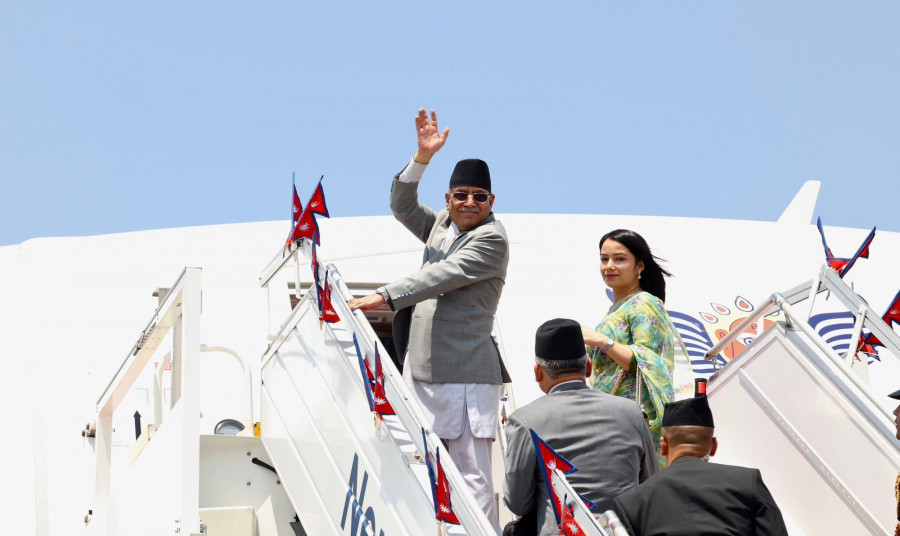Columns
Saffronisation of Dahal’s diplomacy
The India visit has opened up prospects for the integration of Nepali and Indian economies.
Achyut Wagle
Prime Minister Pushpa Kamal Dahal tangibly exuded a sense of achievement and content upon landing at Kathmandu airport on Saturday after completing a four-day official visit to India. Even before embarking on the trip, he seemed to have decided to be pragmatic and focus on economic issues instead of getting entangled in drawn out issues like the Kalapani-Limpiyadhura border dispute. His single political objective was to win the “personal” confidence of his Indian counterpart Narendra Modi. However, it was difficult to decipher whether his smugness was due to having clinched critical economic deals or projected his new avatar as a conservative Hindu venerating Lord Shiva on camera. Both these facets have their own ramifications in national politics.
Despite the harsh criticism of the operational and protocol aspects of Dahal's Delhi junket, it has opened up prospects of the integration of the Nepali and Indian economies. Out of four items on the economic agenda, three seemed to have been resolved amicably. First, the Nepal-India transit treaty has been renewed and the way has been opened for the use of waterways for the transportation of goods.
Oil pipelines
Second, the power trade agreement enabling Nepal to export up to 10,000 megawatts to India in the next 10 years is an important milestone, even though it has expected a 25-year deal. More importantly, India's nod for the commencement of wheeling service to export 50 megawatts to Bangladesh via Indian transmission lines opens up prospects for Nepal to trade power in the subcontinent.
But the pact to construct two oil pipelines—Siliguri-Kakarbhitta and Amlekhgunj-Chitwan—is contradictory. Nepal will need at least 15,000 megawatts to replace gas burning cooking stoves. The pipeline projects are also anachronistic in light of the increased global emphasis on replacing fossil fuels. Nepal will need a significantly higher amount of electricity for a moderate level of industrialisation, urbanisation and green transport infrastructure. Also, the electricity produced in Nepal can easily be consumed domestically for several decades to come.
If the whole idea of exporting electricity is to offset the ever-ballooning trade deficit, this can be better addressed by substituting imported petroleum products with hydropower. Nevertheless, presenting evidence of a readily available export market for Nepal's electricity may encourage investors to put money in hydropower development. Therefore, the power trade agreements need not necessarily be portrayed as an achievement of Dahal's visit. Nepal needs to emerge out of the confusion over its policy on energy production, consumption and energy mix.
Third, signing a memorandum of understanding for cross-border digital payment between Nepal Clearing House and National Payment Corporation of India is an important step towards integrating the Nepali and Indian economies formally. In fact, the two economies are quite well integrated informally. For example, Indian currency notes of Rs500 and higher denominations are illegal in Nepal. But the informal market accepts notes of any denomination and in any amount, and billions of rupees worth of notes are in circulation in the Nepali market. The impractical restriction on carrying high denomination notes has only made things difficult for tourists, students and pilgrims on either side of the border.
Considering the fact that two-thirds of Nepal's international trade is conducted with India, it makes sense to facilitate payment through digital platforms. Such payments are transparent and traceable and happen in real time. The system should support businesses in both countries. But there are people in policymaking circles and businesses working to block this process from coming into operation. There are orthodox regulators who think that digital payment gateways will drain out Nepal's foreign currency reserves in no time. Businesses that have thrived by using non-transparent payment transfers and engaging in blatant under-invoicing of imported goods wish to subvert the entire plan.
The fourth expectation of the prime minister to convince Indian authorities to grant an air entry route from the westernmost Nepali city of Mahendranagar did not materialise. For lack of a direct route, Nepal's newly constructed Gautam Buddha International Airport in Bhairahawa is facing challenges to attract international airlines.
The saffron hiccup
To the great astonishment of many, the prime minister and his entourage took time out to be in the company of Hindu preachers and ascetics widely labelled as the “saffron brigade”. Draped in saffron dhotis, Dahal and six cabinet ministers, including those who were supposedly indoctrinated in Mao Tse-tung's Cultural Revolution, participated in Hindu rituals, and were even seen bowing to a young guru who was seated higher than them.
The political or diplomatic rationale behind the prime minister's participation in such events could hardly be established except for expressing cultural allegiance to the ruling Bharatiya Janata Party's predominantly rightwing Hindutva politics. Back home, in Nepal's domestic politics, the saffronisation adventure of Maoist “atheists” certainly will enthuse those who want to replace the constitutional provision of “secularism” with the declaration of Nepal as a “Hindu state”. Thus, it was an unnecessary hiccup in Dahal's Delhi diplomacy.




 15.12°C Kathmandu
15.12°C Kathmandu















